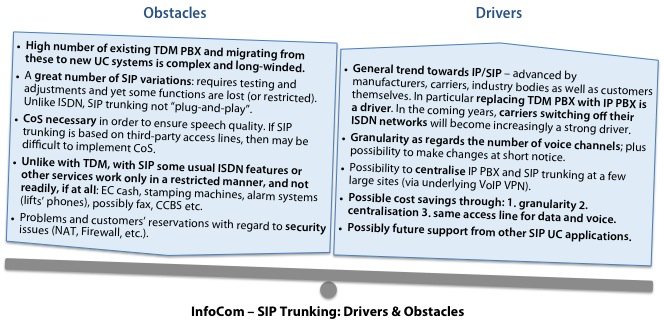These are just some of the key findings of a recent study that InfoCom carried out. The re-search analyses some of the main technical architectures, features and SLAs of the offers of a selection of SIP trunking providers active in Western Europe, including large international pro-viders — targeting mainly large enterprises — as well as local providers targeting mainly SMEs.
The research also highlights the distinct advantage of SIP trunking in terms of granularity and flexibility towards the number of voice channels, as it allows any number of voice channels, unlike ISDN. An additional combined advantage of SIP trunking and IP PBX is also the possi-bility to centralise the voice channels. Through an underlying VoIP VPN, companies can choose to have IP PBX and SIP trunking only in one central site (or a few main sites). Therefore, as a result of granularity, flexibility and centralisation, companies may achieve significant cost savings.
Finally, a possible future advantage is the support of other SIP-based UC (Unified Communi-cation) applications. Currently UC applications (unified messaging, presence, video confer-encing) are confined mainly within a company’s own VPN sites. However, in the future, SIP trunking could enable some of these UC functions to work not only between all the sites of a company — even those not linked via a VPN — but also with third parties.
Despite these clear benefits, the implementation of SIP trunking presents also some disadvan-tages. First of all, IP migrations usually require a (very) long time to be implemented and therefore also to produce the associated benefits. Besides, the still large number of installed TDM/ISDN PBX as well as compatibility and security issues slow the IP migration processes fur-ther down. As a consequence, overall, InfoCom expects only a gradual and constant growth for SIP trunking over the next years, without any exponential take-off and no swift demise of ISDN or analogue connections.
About this extract: These are some of the results of a recent study conducted by InfoCom surveying SIP Trunking providers about offers currently available for business customers. The study analyses some of the main technical architectures, features and SLAs of SIP trunking providers active in Western Europe. The research provides with an analysis of the main drivers and obstacles for SIP trunking in order to reach a conclusion regarding its market potential. If you are interested to know more, do not hesitate to get in contact with us. Talk to us. We listen.

